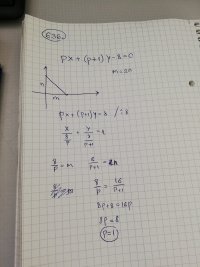You are using an out of date browser. It may not display this or other websites correctly.
You should upgrade or use an alternative browser.
You should upgrade or use an alternative browser.
Equation cordinates
- Thread starter Loki123
- Start date
Dr.Peterson
Elite Member
- Joined
- Nov 12, 2017
- Messages
- 16,865
Are you saying that you were told there are two answers, p=1 and p=1/3?In the following equation, determine p so that m=2n (m being the x coordinate of the point of the x axis and n being the y cordinate on y axis).
I got 1, which is correct, but I also need 1/3, how do I get that?
View attachment 31050
Did you check that answer, by finding the intercepts when p=1/3? You'll find that they are 24 and 6, which are not in the required ratio.
Yes the solution states that p can equal 1 or 1/3.Are you saying that you were told there are two answers, p=1 and p=1/3?
Did you check that answer, by finding the intercepts when p=1/3? You'll find that they are 24 and 6, which are not in the required ratio.
How do I find those intercepts?Are you saying that you were told there are two answers, p=1 and p=1/3?
Did you check that answer, by finding the intercepts when p=1/3? You'll find that they are 24 and 6, which are not in the required ratio.
Dr.Peterson
Elite Member
- Joined
- Nov 12, 2017
- Messages
- 16,865
You clearly know how to find intercepts; you used one method in solving the problem, didn't you?How do I find those intercepts?
But the most straightforward way is to set x to zero and solve for y, and vice versa. If p = 1/3, the equation is 1/3 x + 4/3 y = 8. When y=0, x= ...
Book answers can be wrong, or misread. What does it say, exactly?Yes the solution states that p can equal 1 or 1/3.
Sorry for responding now. But the problem did state that p=1 and p=1/3. No explanation.You clearly know how to find intercepts; you used one method in solving the problem, didn't you?
But the most straightforward way is to set x to zero and solve for y, and vice versa. If p = 1/3, the equation is 1/3 x + 4/3 y = 8. When y=0, x= ...
Book answers can be wrong, or misread. What does it say, exactly?
Loki123, in showing your work, your steps must reflect what you are indicating on
for the side commentary and not be ambiguous.
px + (p + 1)y = 8 \(\displaystyle \ \ \ \ \ \ \ \ \ \ \ \ \ \) Divide both sides by 8:
\(\displaystyle \dfrac{px}{8} \ + \ \dfrac{(p + 1)y}{8} \ = \ 1\)
Now, you are effectively multiplying the first fraction by its numerator and denominator
by 1/p, and you are multiplying the second fraction by its numerator and denominator
by 1/(p + 1). You must have grouping symbols, as in the following result:
\(\displaystyle \dfrac{x}{(\tfrac{8}{ \ p \ })} \ + \ \dfrac{y}{(\tfrac{8}{ \ p + 1 \ })}\ = \ 1\)
for the side commentary and not be ambiguous.
px + (p + 1)y = 8 \(\displaystyle \ \ \ \ \ \ \ \ \ \ \ \ \ \) Divide both sides by 8:
\(\displaystyle \dfrac{px}{8} \ + \ \dfrac{(p + 1)y}{8} \ = \ 1\)
Now, you are effectively multiplying the first fraction by its numerator and denominator
by 1/p, and you are multiplying the second fraction by its numerator and denominator
by 1/(p + 1). You must have grouping symbols, as in the following result:
\(\displaystyle \dfrac{x}{(\tfrac{8}{ \ p \ })} \ + \ \dfrac{y}{(\tfrac{8}{ \ p + 1 \ })}\ = \ 1\)
Last edited:

